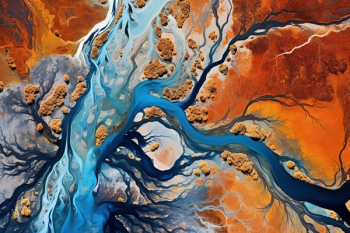Key Points
- Researchers combined remote SWIR imaging and Raman spectroscopy for in situ salt and moisture mapping.
- Sodium sulfate phases were monitored through distinct spectral features in controlled drying tests.
- Machine learning clustered 100 million spectra to map salt damage at Fort Brockhurst (Gosport, England).
- Raman confirmed salt types and hydration states, enabling targeted preservation strategies.
Preserving the Past with Cutting-Edge Optics
A multinational team of researchers has introduced a novel, noninvasive technique to identify and monitor destructive salt and moisture accumulation inside historic buildings. The work—led by Sotiria Kogou and colleagues from Nottingham Trent University (Nottingham, United Kingdom), University of Science and Technology Beijing (Beijing, China), and English Heritage (Swindon and London, United Kingdom)—was recently published in Analytical Chemistry (1).
Their approach harnesses ground-based remote shortwave infrared and near-infrared (SWIR/NIR) spectral imaging and remote Raman spectroscopy, enhanced by machine learning, to map and characterize salts in varying hydration states from up to 10 meters away (1).
Spectroscopy Meets Heritage Conservation
Salt crystallization in the porous materials of old masonry structures is a major cause of damage. Particularly problematic is sodium sulfate (Na₂SO₄), which expands over 300% when it converts from its anhydrous form (thenardite) to its hydrated form (mirabilite). This expansion can cause severe mechanical stress, contributing to cracking, scaling, and material loss (1).
While traditional laboratory-based techniques can identify these salts, they are often labor-intensive, invasive, and prone to errors due to phase transitions during sampling. “We needed an in situ method that wouldn’t harm the structure and could provide immediate, large-scale diagnostic insights,” said Kogou (1).
Dual-Sensor Strategy
To meet this need, the researchers combined two complementary spectroscopic methods. The first, SWIR spectral imaging (covering the NIR spectral region from 1000–2500 nm), was used to scan entire wall surfaces at high angular resolution (45 μrad), detecting moisture and salts based on their distinct spectral absorption bands (1).
Key NIR absorption features at 1200, 1450, 1775, and 1900 nm—related to water bending and stretching modes—enabled the team to discriminate between various hydration states of salts. A neural-network-based clustering algorithm grouped spectrally similar regions, revealing spatial patterns invisible to the naked eye (1).
The second method, remote Raman spectroscopy (using a 780 nm laser), provided chemical specificity by identifying sulfate vibrational modes. Raman signatures confirmed the presence of mirabilite, thenardite, and even intermediate states such as heptahydrate and mixed phases (1). Raman and remote infrared have been implemented regularly for historical and heritage research (1–3).
Mock Experiments Validate Technique
The system was validated through controlled drying experiments using sodium sulfate solutions. Five distinct spectral phases were observed during drying—from pure solution to fully anhydrous salt. SWIR spectral transitions matched well with corresponding changes in Raman spectra, particularly in the ν₁ vibrational mode of SO₄²⁻. Spectral deconvolution revealed coexistence of salt phases in transitional states, showcasing the technique’s ability to monitor dynamic chemical changes (1).
Real-World Application: Fort Brockhurst
The method was then applied in the field at Fort Brockhurst, a 19th-century Palmerston Fort in Gosport, England. Its underground caponiers suffer from chronic dampness and severe salt weathering. Using their dual-sensor platform, the team scanned over 6.5 square meters of wall surface, generating more than 100 million spectra (1).
Machine learning algorithms clustered the data into spectrally distinct zones, correlating with varying moisture levels and salt compositions. Raman verification within each zone confirmed the presence of mirabilite and thenardite. This spatially resolved identification offers conservators a powerful tool to prioritize remediation efforts (1).
A Leap Forward in Conservation Science
This breakthrough in remote spectral imaging and AI-assisted analysis allows heritage professionals to diagnose and monitor salt and moisture damage with unprecedented precision, without touching or sampling the structure (1). Applications of infrared and Raman for heritage studies have been more commonly used over the past decade (2,3).
As co-author Haida Liang stated, “This work represents a shift from reactive conservation to proactive and predictive monitoring of our cultural heritage” (1).
References
(1) Kogou, S.; Li, Y.; Cheung, C. S.; Han, X. N.; Liggins, F.; Shahtahmassebi, G.; Thickett, D.; Liang, H. Ground-Based Remote Sensing and Machine Learning for In Situ and Noninvasive Monitoring and Identification of Salts and Moisture in Historic Buildings. Anal. Chem. 2025, 97 (9), 5008–5013. DOI: 10.1021/acs.analchem.4c05581
(2) Moosavinejad, S. M.; Madhoushi, M.; Vakili, M.; Rasouli, D. Evaluation of Degradation in Chemical Compounds of Wood in Historical Buildings Using FT-IR and FT-Raman Vibrational Spectroscopy. Maderas Cienc. Tecnol. 2019, 21 (3), 381–392. DOI: 10.4067/S0718-221X2019005000310
(3) Schmid, T.; Dariz, P. Determination and Imaging of Binder Remnants and Aggregates in Historic Cement Stone by Raman Microscopy. J. Raman Spectrosc. 2013, 44 (6), 882–891. DOI: 10.1002/jrs.4296






